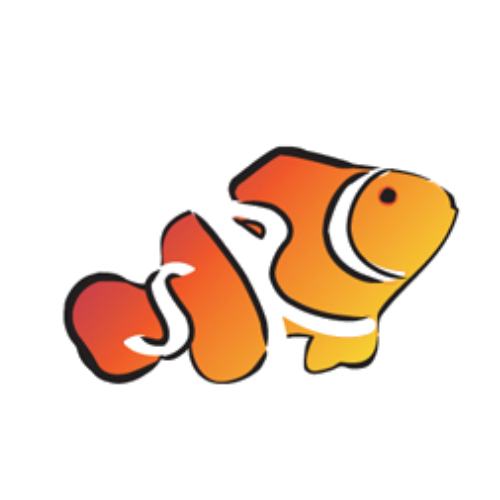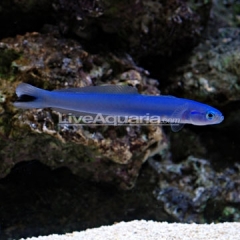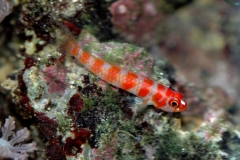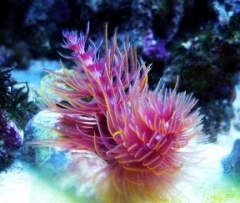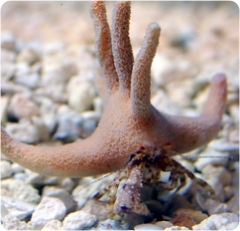-
Posts
8,253 -
Joined
-
Last visited
-
Days Won
31
Content Type
Profiles
Forums
Gallery
Everything posted by Harlequinmania
-
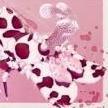
Blue Gudgeon Dartfish (Ptereleotris heteroptera)
Harlequinmania posted a gallery image in Microdesmidae
Minimum Tank Size: 30 gallons Care Level: Easy Temperament: Peaceful Reef Compatible: Yes Water Conditions: 72-78° F, dKH 8-12, pH 8.1-8.4, sg 1.020-1.025 Max. Size: 5" Color Form: Blue, Green, White Diet: Carnivore Origin: Fiji, Indonesia Family: Microdesmidae The Blue Gudgeon Dartfish, commonly referred to as the Blacktail Goby or Blacktail Dartfish, originates from the reefs of Fiji. They have an elongated body, which is pale blue or green in color with a prominent black spot on their tail. They enjoy being in pairs, and make a wonderful fish for a fish only or reef aquarium. It should be housed in a 30 gallon or larger aquarium with plenty of loose coral rubble, and requires ample swimming room with a sand bottom for burrowing. It may try to jump out of the aquarium or other small opening, so a tight-fitting lid is required. Rarely will it become aggressive towards other fish. It feeds mostly on prey suspended in the water column, but will pick food off the substrate as well. The Blue Gudgeon Dartfish feeds on a diet which includes mysis shrimp, brine shrimp, table shrimp, and frozen food preparations for carnivores. It should be fed at least three times per day. Approximate Purchase Size: 3" to 4" ** Information extarcted from liveaquaria.com© www.sgreefclub.com
-
Minimum Tank Size: 10 gallons Care Level: Easy Temperament: Peaceful Reef Compatible: Yes Water Conditions: 72-78° F, dKH 8-12, pH 8.1-8.4, sg 1.020-1.025 Max. Size: 1" Color Form: Red, Yellow Diet: Carnivore Origin: Cebu Family: Gobiidae The Red Spotted Goby originating from the reefs of Cebu is a rare find in the industry. They are smaller gobies, only reaching a total length of 1 inch. Their body is opaque in color with many red irregularly shaped spots. Their eyes are very large for their size and are also spotted in red and gold. They are very active and peaceful gobies that will make a wonderful addition to the saltwater reef, nano or fish only aquarium. It should be kept in a 10-gallon or larger aquarium with plenty of live rock for hiding and as a supplemental food source. Small groups, or pairs, tend to do better in an aquarium, but need to be introduced to the tank simultaneously. Do not house these gobies with larger, aggressive fish or invertebrates. The diet should consist of a variety of fresh or frozen seafood, brine shrimp, and mysis shrimp. ** Information extarcted from liveaquaria.com
© www.sgreefclub.com
-
Minimum Tank Size: 10 gallons Care Level: Easy Temperament: Peaceful Reef Compatible: Yes Water Conditions: 72-78° F, dKH 8-12, pH 8.1-8.4, sg 1.020-1.025 Max. Size: 1" Color Form: Red, White Diet: Carnivore Origin: Cebu Family: Gobiidae The Red Striped Goby, originating from the reefs of Cebu, is a rare find in the industry. They are smaller gobies, only reaching a total length of 1 inch. Their body is elongated and opaque in color with red vertical stripes. Their large eyes stand out with their gold rims. They are very active and peaceful gobies that will make a wonderful addition to the saltwater reef or fish only aquarium. It should be kept in a 10-gallon or larger aquarium with plenty of live rock for hiding and as a supplemental food source. Small groups, or pairs, tend to do better in an aquarium, but need to be introduced to the tank simultaneously. Do not house these gobies with larger, aggressive fish or invertebrates. The diet should consist of a variety of fresh or frozen seafood, brine shrimp, and mysis shrimp. It needs to be fed twice per day. ** Extarcted from liveaquaria.com
© www.sgreefclub.com
-
FAMILY - Gobidae SCIENTIFIC NAME - Amblyeleotris Laifasciata COMMON NAME - Spottail or Metallic Shrimp Goby SIZE - 5.1" (13 cm) RANGE - Western Pacific MIN. AQUARIUM SIZE - 20 US Gal. (76 L) FOODS AND FEEDING - Varied meaty diet of live and frozen foods for carnivores. Feed min. 2 times a day AQUARIUM SUITABILITY - 8 REEF COMPATIBILITY - May be a threat to small ornamental shirmp, excellent reef fish CAPTIVE CARE - May not feed for several days after introduced to the tank so give it a couple days to acclimate to the new surroundings and it should then start to feed, Can be kept with other shrimp gobies and may share a common burrow, as long as the aquarium is large enough more than one can be kept, males may quarrel without damage if the tank is too small, The fishes long spoted top fin is a target for tankmates that like to nip fins, keep in a peaceful community tank, a shrimp is not needed to be successful with this fish. ** Extracted from livingreefs.com
© www.sgreefclub.com
-
Care Level: Difficult Temperament: Peaceful Reef Compatible: Yes Waterflow: Low to Medium Placement: Bottom Water Conditions: 72-78° F, dKH 8-12, pH 8.1-8.4, sg 1.023-1.025 Max. Size: 7" Color Form: Orange, Pink, Red, White, Yellow Diet: Filter Feeder Supplements: Calcium, Magnesium, Strontium, Trace Elements Origin: Indo-Pacific Family: Serpulidae The Hard Tube Coco Worm, also known as the Hard Tube Feather Duster, Protula Tubeworm, or Hard Tubeworm, has a crown that can be white, yellow, orange, pink, or red. The radioles may be banded or patterned. Younger Hard Tube Coco Worms have bi-lobed crowns, while the crowns of older individuals are spiraled. The Hard Tube Coco Worm secretes a calcareous tube, approximately 1/2 inch in diameter and 5-8 inches long, to house its vulnerable worm body. When disturbed, it can quickly retract its crown and close its operculum to shut the top of its tube. It usually anchors its tube in a crevice of the rocky reef or in the gravel along current-swept reef slopes. It uses the radioles to filter out floating plankton. The aquarium for the Hard Tube Coco Worm should be well-established and contain a rock and gravel substrate. The Hard Tube Coco Worm requires calcium and the proper alkalinity to grow. It is extremely intolerant of poor water quality and copper-based medications. In the aquarium it is difficult to maintain, and will need supplements of phytoplankton and liquid organic foods. ** information extracted from liveaquaria.com
© www.sgreefclub.com
-
Care Level: Difficult Temperament: Peaceful Reef Compatible: With Caution Water Conditions: 72-78° F, dKH 8-12, pH 8.1-8.4, sg 1.023-1.025 Max. Size: 2" Diet: Herbivore Origin: Indo-Pacific Family: Paguridae The Staghorn Hermit Crab, sometimes called the Antler Hermit, or Coralhouse Hermit Crab is an unusual crab that requires specialized care by the more advanced hobbyist, and is well suited for the biotope or DSB (deep sand bed) refugium. These hermits are found along the reef faces and coral rubble zones throughout the Indo-Pacific. They scavenge animal matter and algae. The Staghorn Hermit Crab lives in a branching shell that is covered with hydroids and bryozoans. The crab itself is a hardy companion for the aquarium, but the shell that it resides in requires specialized care. This shell has multiple branches that resemble the branching SPS coral Acropora. Because of its shell, this crab may not be able to right itself if it were to fall on its back, and will be stung and damaged by corals and anemones in the reef aquarium. Staghorn hermits are best kept in a biotope system with other filter feeding invertebrates, or in a refugium where the hydroids and bryozoans on its shell can be fed properly with types of live or prepared plankton foods. The biotope system or refugium is an ideal location due to the fact the shell must not come in contact with stinging corals and anemones. The crab itself will graze on algae, and if there is an insufficient supply to eat, supplement the diet with offerings of dried seaweed. ** information extracted from liveaquaria.com
© www.sgreefclub.com
-
A new oyster farming initiative has launched in the northern Gulf of Mexico. The goal of this effort is industry adoption of off-bottom oyster culture to supplement the traditional harvest. Historically, oysters are grown on and harvested from reefs on the water bottom. In this new process, oysters are grown suspended in the water column. View the full article
-
The northern bottlenose whale is a strange creature. They have a long, stout body with a bulbous forehead -- called a "melon" -- and a short, tube-like snout. Hunted for centuries for their oil (and until the 1970s for dog food), there may be only 160 of these gentle giants in the population found off Nova Scotia. View the full article
-
In the 24-hour news cycle era, the Deepwater Horizon oil leak in the Gulf of Mexico already feels like an event from yesteryear, an event that had its 15 minutes of news domination during the summer of 2010 then made room for the next big story once the wellhead was capped. But though gulf residents fear that they will be forgotten as cleanup crews pack up and leave, the inquiry into the oil leak is only beginning on scientific fronts. View the full article
-
On the rocks just beneath the tides, the faster the water is moving in an area, the greater the variety of invertebrate creatures that will live there. Understanding that water flow is a strong predictor of diversity could be a huge boon to efforts to manage coastal ecosystems. View the full article
-
Scientists have developed a new kind of underwater sonar device that can detect objects through bubble clouds that would effectively blind standard sonar. View the full article
-
Disrupting the stress response in zebrafish generates behaviors that resemble depression, according to new research. Zebrafish are popular model systems in many areas of biomedical research, but this is the first discovery of a zebrafish mutant with an apparent psychiatric disorder. View the full article
-
Coral reefs suffered record losses as a consequence of high ocean temperatures in the tropical Atlantic and Caribbean in 2005 according to the most comprehensive documentation of basin-scale bleaching to date. Collaborators from 22 countries report that more than 80 percent of surveyed corals bleached and over 40 percent of the total surveyed died, making this the most severe bleaching event ever recorded in the basin. View the full article
-

New large squid found in southern Indian Ocean
Harlequinmania posted a topic in General Reefkeeping_
A new species of squid has been discovered by scientists analyzing 7,000 samples gathered during a seamounts cruise in the southern Indian Ocean last year. View the full article -

New large squid found in southern Indian Ocean
Harlequinmania posted a topic in General Reefkeeping_
A new species of squid has been discovered by scientists analyzing 7,000 samples gathered during a seamounts cruise in the southern Indian Ocean last year. View the full article -
Gill disease may have several different causes, such as adverse environmental impacts or a variety of microorganisms. Researchers have identified microorganisms that may lead to gill disease, thereby making a significant contribution to our understanding of such diseases in farmed salmon. View the full article
-
Terry discusses his latest endeavour with freshwater Discus. View the full article
